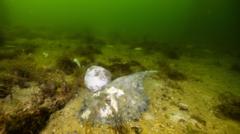An ongoing algal bloom has turned the typically clear waters of South Australia into a toxic green nightmare, leading to severe environmental and economic consequences. State Premier Peter Malinauskas has termed the situation a "natural disaster," despite the federal government refraining from doing so. The bloom, driven by climate change factors such as ocean warming and nutrient pollution, has intensified since March and currently spans an area double that of the Australian Capital Territory.
More than 400 marine species have perished due to the toxic conditions, causing significant disruption to local industries. In response, the federal government announced a financial aid package of A$14 million (approximately $9 million), which the state government pledged to match for research and cleanup efforts. However, Malinauskas insists that the disaster's designation as such should recognize the real challenges faced by the marine ecosystem and local communities.
Criticism is mounting against the federal government, particularly from Greens Senator Sarah Hanson-Young, who suggests a more urgent response would be evident if such devastation occurred in more prominent locations like Bondi Beach. Environment Minister Murray Watt acknowledges the severity but maintains it does not align with the legal definitions of a natural disaster.
The alarming reality remains: the algal bloom—stretching from Coorong to Yorke Peninsula—has left local fishermen devastated and struggling financially. Ian Mitchell, an intermediary in the fishing industry, described the emotional toll on fishers, many of whom have seen a complete halt in their income for months. Brad Martin of OzFish characterized the situation graphically, likening it to a horror film unfolding under the waves. The crisis highlights the urgent need for strategic climate actions to mitigate such ecological disasters.






















